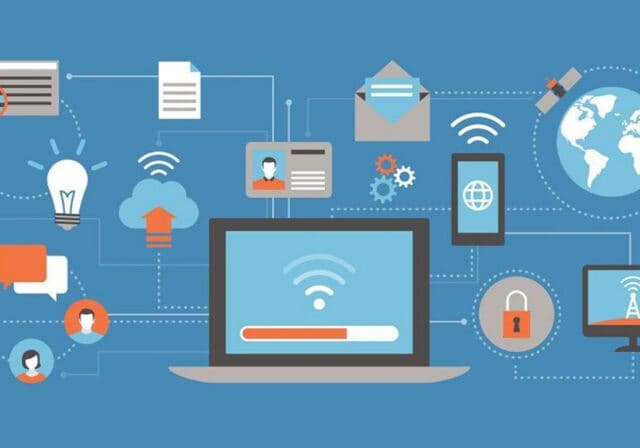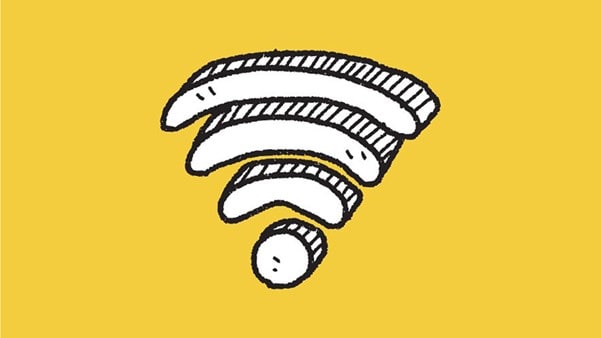What does Wi-Fi stand for?
Let's start with what "Wi-Fi" actually stands for, which many assume is "wireless fidelity" (just like Hi-Fi stands for "high fidelity"). But they would be wrong. The truth is that Wi-Fi doesn’t actually stand for anything. A founding member of the Wi-Fi Alliance confirmed this in an interview. He said they hired a firm to help them market the technology and they chose the term "Wi-Fi" from a list of 10 possible names:
"We needed something that was a little catchier than "IEEE 802.11b Direct Sequence…So we compromised and agreed to include the tag line "The Standard for Wireless Fidelity" along with the name..."
If you’re curious about some of the other options they considered naming it, here are just a few:
- Prozac (yes, like the drug)
- Compaq
- Oneworld
- Imation
- Vivato
What is Wi-Fi exactly?
Wi-Fi is a way of connecting devices on a local area network (LAN). Before the days of Wi-Fi, the only way to connect devices to the internet was through individual cables, which was often inconvenient. By creating an individual Wi-Fi network, users could now connect laptops, phones, smart devices, and any other enabled devices both to each other and the internet within a home or office using a secure network.
Who created Wi-Fi? Hollywood meets science
Like many inventions, multiple people can be credited with the ideation behind Wi-Fi. Interestingly, a 1930s-and-40s Hollywood legend (and self-taught scientist) played a crucial role in the development of Wi-Fi. She received a patent for a "Secret Communications System" that let radio waves jump onto different frequencies in an effort to stop the enemy from jamming the US Navy’s radio signals during World War 2.
While that alone was not the invention, the concept ultimately led to Wi-Fi.
So, how was today's Wi-Fi created? Like we stated, many people played a role in its creation. However, the committee chairperson in the late 1990s, who created the IEEE 802.11 standards we mentioned earlier, is usually credited with the invention of Wi-Fi.
When did Wi-Fi become popular?
Here's a handy timeline that puts it all in perspective:
- 1999: Six companies form the Wireless Ethernet Compatibility Alliance (WECA).
- 2000: The organization becomes the Wi-Fi Alliance. Wi-Fi data rates reach up to 11 Mbps.
- 2004: The first Wi-Fi-certified devices (cell phones, PDAs and TVs) hit the market. The first in-flight Wi-Fi is offered on commercial aircraft.
- 2005: The term "Wi-Fi" is added to the Merriam-Webster English Dictionary.
- 2007: Wi-Fi now offers dual-band operation and 150 Mbps.
- 2010: Wi-Fi Direct delivers peer-to-peer connectivity.
- 2013: New standards break the Wi-Fi gigabit barrier. Global hotspots reach 5+ million.
- 2016: WiGig® brings multi-gigabit performance.
- 2017: Wi-Fi device shipments reach 20 billion.
- 2019: Wi-Fi 6 delivers next-gen connectivity as the 30-billionth Wi-Fi device ships.
- 2020: Wi-Fi 6E is released.
- 2021: The first Wi-Fi 6E routers and devices became available.
- 2023: Wi-Fi 7 devices start appearing for early adopters.
How does Wi-Fi work in your home?
Wi-Fi links devices to one another so that they are able to quickly and wirelessly share and backup data, print, or perform any other activity that requires a connection. However, in order to download data from the internet, Wi-Fi always requires an internet connection. For home Wi-Fi, that typically meant connecting your wireless network to the internet with a device called a modem, which plugs into the internet depending on what type of service you have—cable, satellite, or fiber.
From there, your router connects to the modem (in the past, it was usually via ethernet cable) to create one secure network for all your devices.
How is wireless technology changing home internet today?
Massive improvements in wireless technology, including Wi-Fi 6 and beyond, coupled with advances in 5G technology, has people cutting the cord like never before, particularly in the form of 5G home internet service, which now allows you to stream content, play games, and browse the web across multiple devices in your home.
If you’re a T-Mobile Home Internet customer, for example, our Home Internet utilizes a wireless 5G Gateway that works in tandem with Wi-Fi 6 and is compatible with T-Mobile's nationwide 5G network. Once you sign up, the 5G Gateway is delivered to your home. No complicated installation. Just one cord to plug it in.
T-Mobile is America’s fastest growing Home Internet provider. Find out if it's available in your area and then try it out for 15 days to see if it works for you.
Sources:
- https://boingboing.net/2005/11/08/wifi-isnt-short-for.html
- https://www.newscientist.com/question/what-does-wi-fi-stand-for/
- https://www.forbes.com/sites/shivaunefield/2018/02/28/hedy-lamarr-the-incredible-mind-behind-secure-wi-fi-gps-bluetooth/
- https://www.science-sparks.com/who-invented-wi-fi/
- https://prologue.blogs.archives.gov/2020/05/26/the-world-war-ii-era-actress-that-invented-wi-fi-hedy-lamarr/
- https://beambox.com/townsquare/who-invented-wifi
- https://www.wi-fi.org/sites/default/files/public/Infographic_20_years_of_Wi-Fi.pdf



